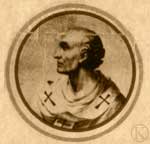POPE BENEDICT IX
151ST Pope (1047-1048)

Home
Kolbe Library
Annals of Catholicism
The nephew of his two immediate predecessors, Benedict IX was a man of very different character to either of them. He was a disgrace to the Chair of Peter. Regarding it as a sort of heirloom, his father Alberic placed him upon it when a mere youth, not, however, apparently of only twelve years of age (according to Raoul Glaber, Hist., IV, 5, n. 17. Cf. V, 5, n. 26), but of about twenty (October, 1032). Of his pontifical acts little is known, except that he held two or three synods in Rome and granted a number of privileges to various churches and monasteries. He insisted that Bretislav, Duke of Bohemia, should found a monastery, for having carried off the body of St. Adalbert from Poland. In 1037 he went north to meet the Emperor Conrad and excommunicated Heribert, Archbishop of Milan, who was at emnity with him (Ann. Hildesheimenses, 1038). Taking advantage of the dissolute life he was leading, one of the factions in the city drove him from it (1044) amid the greatest disorder, and elected an antipope (Sylvester III) in the person of John, Bishop of Sabina (1045 -Ann. Romani, init. Victor, Dialogi, III, init.). Benedict, however, succeeded in expelling Sylvester the same year; but, as some say, that he might marry, he resigned his office into the hands of the Archpriest John Gratian for a large sum. John was then elected pope and became Gregory VI (May, 1045). Repenting of his bargain, Benedict endeavoured to depose Gregory. This resulted in the intervention of King Henry III. Benedict, Sylvester, and Gregory were deposed at the Council of Sutri (1046) and a German bishop (Suidger) became Pope Clement II. After his speedy demise, Benedict again seized Rome (November, 1047), but was driven from it to make way for a second German pope, Damasus II (November, 1048). Of the end of Benedict it is impossible to speak with certainty. Some authors suppose him to have been still alive when St. Leo IX died, and never to have ceased endeavouring to seize the papacy. But it is more probable that the truth lies with the tradition of the Abbey of Grottaferrata, first set down by Abbot Luke, who died about 1085, and corroborated by sepulchral and other monuments within its walls. Writing of Bartholomew, its fourth abbot (1065), Luke tells of the youthful pontiff turning from his sin and coming to Bartholomew for a remedy for his disorders. On the saint's advice, Benedict definitely resigned the pontificate and died in penitence at Grottaferrata. [See "St. Benedict and Grottaferrata" (Rome, 1895), a work founded on the more important "De Sepulcro Benedicti IX", by Dom Greg. Piacentini (Rome, 1747).]
The most important source for the history of the first nine popes who bore the name of Benedict is the biographies in the Liber Pontificalis, of which the most useful edition is that of Duchesne, Le Liber Pontificalis (Paris, 1886-92), and the latest that of Mommsen, Gesta Pontif. Roman. (to the end of the reign of Constantine only, Berlin, 1898). Jaffé, Regesta Pont. Rom. (2d ed., Leipzig, 1885), gives a summary of the letters of each pope and tells where they may be read at length. Modern accounts of these popes will be found in any large Church history, or history of the City of Rome. The fullest account in English of most of them is to be read in Mann, Lives of the Popes in the Early Middle Ages (London, 1902, passim).
HORACE K. MANN
|



